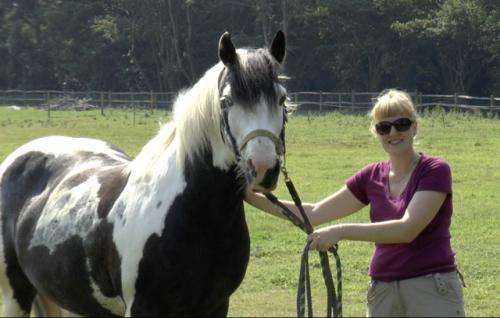Horses communicate with their eyes and mobile ears

Horses are sensitive to the facial expressions and attention of other horses, including the direction of the eyes and ears. The findings, reported in the Cell Press journal Current Biology on August 4, are a reminder for us humans to look beyond our own limitations and recognize that other species may communicate in ways that we can't, the researchers say. After all, human ears aren't mobile.
"Our study is the first to examine a potential cue to attention that humans do not have: the ears," says Jennifer Wathan of the University of Sussex. "Previous work investigating communication of attention in animals has focused on cues that humans use: body orientation, head orientation, and eye gaze; no one else had gone beyond that. However, we found that in horses their ear position was also a crucial visual signal that other horses respond to. In fact, horses need to see the detailed facial features of both eyes and ears before they use another horse's head direction to guide them."
The new study also challenges the earlier held notion that animals with eyes to the sides of their heads cannot glean information based on the direction of one another's gaze.
Wathan and the study's senior author Karen McComb took photographs to document cues given by horses when they were paying attention to something. Then Wathan and McComb used those photographs as life-sized models for other horses to look at as they chose between two feeding buckets. In each case, the horse in the photo was paying attention to one of the buckets and not the other. In some instances, the researchers also manipulated the image to remove information from key facial areas, including the eyes and the ears.
The researchers' observations show that horses rely on the head orientation of their peers to locate food. However, that ability to read each other's interest level is disrupted when parts of the face—the eyes and ears—are covered up with masks. The ability to correctly judge attention also varied depending on the identity of the horse pictured, suggesting that individual facial features may be important, the researchers report.
Wathan and McComb plan to continue to explore facial features related to the expression of emotion in their horses, noting that horses' rich social lives and close relationship to humans make them particularly interesting as study subjects. Our understanding of horses' social lives might also have implications for their welfare.
"Horses display some of the same complex and fluid social organization that we have as humans and that we also see in chimpanzees, elephants, and dolphins," Wathan says. "The challenges that living in these societies create, such as maintaining valuable social relationships on the basis of unpredictable interactions, are thought to have promoted the evolution of advanced social and communicative skills. There is a general interest in studying species with this social structure."
More information: Paper: Current Biology, Wathan et al.: "The eyes and ears are visual indicators of attention in domestic horses."
Journal information: Current Biology
Provided by Cell Press


















